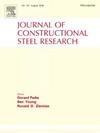预测 CFDST 柱荷载-位移曲线的有效程序
IF 4
2区 工程技术
Q1 CONSTRUCTION & BUILDING TECHNOLOGY
引用次数: 0
摘要
本文采用基于卷积神经网络(CNN)的回归和 Nelder-Mead 方法,提出了一种预测单轴压缩下混凝土填充双层钢管(CFDST)柱的荷载-位移曲线和承载能力的新程序。首先,利用从文献实验中收集的混合数据库和从有限元分析中生成的混合数据库来建立所提出的基于卷积神经网络的模型。通过比较所提模型的预测结果和未见数据,说明了所提模型的准确性。比较采用了两种机器学习模型,包括极梯度提升和多层感知器。可以看出,在实验和数值数据库中,基于 CNN 的模型对 CFDST 柱的载荷-位移曲线和轴向压缩能力的预测最为准确。我们开发了一种有效的程序来校准基于 CNN 的模型所估算的初步荷载-位移曲线,从而显著提高其平滑度和性能。获得了预测 CFDST 柱荷载-位移曲线的调整公式(基于著名方程)。使用 Nelder-Mead 方法对这些公式的超参数进行了优化。结果表明,根据建议程序得到的调整后荷载-位移曲线优于基于 CNN 的模型估计的初步曲线。通过敏感性分析,研究了该模型在随机环境下随着输入变量的变化预测 CFDST 柱荷载-位移曲线的性能。最后,开发了一个基于云的图形用户界面,为用户提供了一个方便的工具,使其无需编程知识即可预测 CFDST 柱的轴向荷载-位移响应。本文章由计算机程序翻译,如有差异,请以英文原文为准。
An efficient procedure for prediction of the load-displacement curve of CFDST columns
This paper proposes a novel procedure for prediction of both load-displacement curve and load-carrying capacity of concrete-filled double-skin steel tube (CFDST) columns under uniaxial compression by using convolutional neural network (CNN)-based regression and Nelder-Mead methods. Firstly, hybrid databases collected from experiments in literature and generated from finite element analyses are employed to build the proposed CNN-based model. The accuracy of the proposed model is described through a comparison between predictive results of the proposed model and unseen data. Two machine learning models, including eXtreme Gradient Boosting and Multilayer Perceptron, are adopted for comparison. It can be observed that the CNN-based model provides the most accurate predictions for both the load-displacement curve and axial compression capacity of CFDST columns in both experimental and numerical databases. An efficient procedure is developed to calibrate the preliminary load-displacement curve estimated by the CNN-based model, and to notably enhance its smoothness and performance. Adjusted formulae (based on well-known equations) are obtained for predicting the load-displacement curve of CFDST columns. The hyperparameters of these formulae are optimized using the Nelder-Mead method. It is indicated that the adjusted load-displacement curves obtained from the proposed procedure outperform the preliminary curves estimated by the CNN-based model. A sensitivity analysis was conducted to investigate the model's performance in predicting the load-displacement curves of CFDST columns with variations of input variables within stochastic environments. Finally, a cloud-based graphical user interface is developed to provide a convenient tool for users to predict axial load-displacement responses of CFDST columns without prior programming knowledge.
求助全文
通过发布文献求助,成功后即可免费获取论文全文。
去求助
来源期刊

Journal of Constructional Steel Research
工程技术-工程:土木
CiteScore
7.90
自引率
19.50%
发文量
550
审稿时长
46 days
期刊介绍:
The Journal of Constructional Steel Research provides an international forum for the presentation and discussion of the latest developments in structural steel research and their applications. It is aimed not only at researchers but also at those likely to be most affected by research results, i.e. designers and fabricators. Original papers of a high standard dealing with all aspects of steel research including theoretical and experimental research on elements, assemblages, connection and material properties are considered for publication.
 求助内容:
求助内容: 应助结果提醒方式:
应助结果提醒方式:


